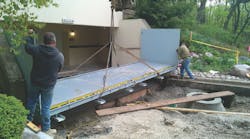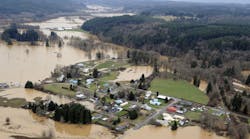Helping Hinsdale
Anthony J. Charlton, P.E., is director of DuPage County Stormwater Management. Charlton can be reached at 630.407.6688.
undefinedLocated in Hinsdale, Ill., just outside of Chicago, the Graue Mill Subdivision is home to more than 340 residences consisting of townhomes and condominiums. The neighborhood is adjacent to Salt Creek, a major tributary to the Des Plaines River that flows along the eastern portion of DuPage County. Graue Mill’s close proximity to the more than 43-mile long stream causes flooding issues. However, adding to the riverine flooding, the densely populated neighborhood also is subject to extensive interior drainage issues and urban flooding.
Residents incurred repetitive flooding throughout the neighborhood, suffering through major floods in 2010 and 2013. During these floods, residents experienced extensive loss of property. Notably, in 2013, an entire underground parking structure and all the cars went under water, and first responders had to evacuate residents using boats and large dump trucks.
Despite these severe flooding issues, solutions were costly and difficult to implement in the highly developed suburban neighborhood with limited open space, mature trees and a significant amount of floodplain, which itself posed extra permitting hurdles.
The Solution
After multiple significant flooding events, it was evident to the village of Hinsdale that it needed to do something to mitigate the situation. Though funding for construction was not yet in place, the village entered into a contract with Christopher B. Burke Eng. LLC to design the much-needed flood control improvements.
Unlike other standard flood control projects, engineers had to account for several aesthetic considerations while designing the project. Retrofitting floodwalls, berms and floodgates into a long-standing and densely populated community was not an easy feat. Ultimately, the design incorporated aesthetic features to make the flood control improvements fit seamlessly with the neighborhood. This included form liners for the concrete walls that were strategically airbrushed to match the color of the existing brick façade and passive floodgates designed to operate solely on water pressure without any electrical intervention.
In total, the project called for more than 2,500 ft of new storm sewer, four pump stations, 13 floodgates, 7.5 acre-ft of compensatory storage, and more than 3,100 ln ft of concrete floodwalls and earthen berms. The engineer’s estimate was nearly $4 million.
Funding
The community was vocal to local governing agencies about the issues in the neighborhood. However, the problem did not lack urgency; it lacked funding. On a local level, the Graue Mill Homeowners Assn., Village of Hinsdale and DuPage County could not financially support all the needed improvements, so the search for funding expanded to the state of Illinois and federal government.
Backed by local agencies, residents successfully championed both federal and state officials to contribute funding to the project. The Federal Emergency Management Agency-via the Illinois Emergency Management Agency-awarded a $2.5 million grant under its Hazard Mitigation Grant Program. In addition, the Illinois Department of Natural Resources provided a more than $600,000 grant to help fund the project. DuPage County’s Stormwater Management Department, the village of Hinsdale and the Graue Mill Homeowners Assn. contributed to the local match, and the Forest Preserve District of DuPage County provided land for the compensatory storage in the nearby Fullersburg Woods Forest Preserve, which was crucial to satisfying strict permit requirements.
Construction
With project design complete and funding in place, construction broke ground in November 2015. The complexity of the work required four competitive bids for multiple phases and three contractors for construction and excavation. DuPage County bid out the work and oversaw construction using in-house engineering staff.
The first phase of work included installing 240 ft of storm underdrains and construction of a floodgate to protect the parking garage that experienced total loss in 2013.
The second phase installed seven additional floodgates to protect two multi-unit dwellings that experienced repetitive flooding. In addition, crews installed 840 ft of concrete floodwall and earthen berms, 880 ft of storm sewer and two pump stations.
Excavation and planting of the 7.5 acre-ft compensatory storage area in the nearby forest preserve was completed in the third phase to compensate for fill placed within the floodplain during previous phases.
Finally, construction completed in phase four with installation of an additional 2,300 ft of concrete floodwall and earthen berms, 1,425 ft of storm sewer, two pump stations and five floodgates to protect both residences and the community clubhouse.
Construction took place in tight spaces with lots of surrounding activity from residents. Some project areas offered less than 20 ft between a building and the adjacent Salt Creek. Work also called for restricted access to portions of the community, sometimes for weeks at a time. Because of this, DuPage County staff had to manage residents and transportation needs as a daily occurrence throughout the entire construction phase.
Nonetheless, construction was substantially completed as planned in October 2018 and currently is in the management phase of native restoration.
Outcome
The Graue Mill Flood Protection Improvement Project exemplified cooperation and partners coming together to establish a project that protects more than 340 residences from repetitive flooding. Project and funding partners included federal, state and local governments, as well as the Graue Mill Homeowners Assn. Constructed at a relatively low cost, the project included more than 2,500 ft of new storm sewer, 3,100 ft of floodwall, 13 floodgates, four pump stations and 2.4 million gal of floodwater storage.
The project has given the Graue Mill community peace of mind knowing that flood protection measures now are in place to protect its belongings and avoid displacement during larger storm events. Residents have endured repetitive flooding, particularly over the past 10 years, and the project’s flood control improvements are already proving beneficial to the community after years of hardship.


